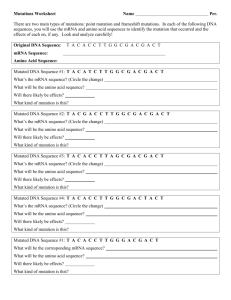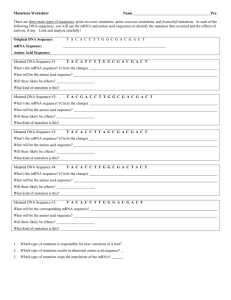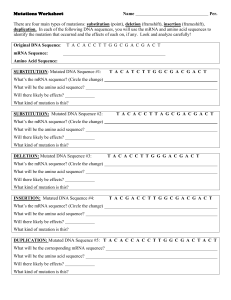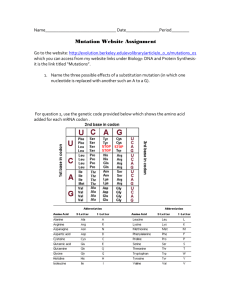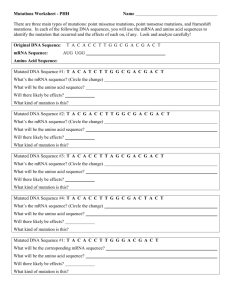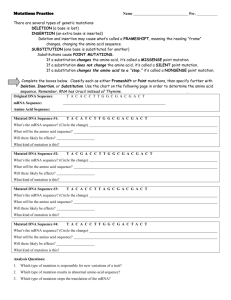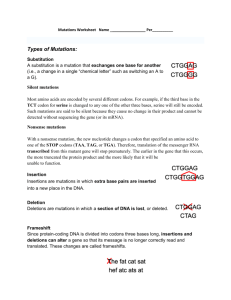Virtual Lab: DNA and Genes
advertisement
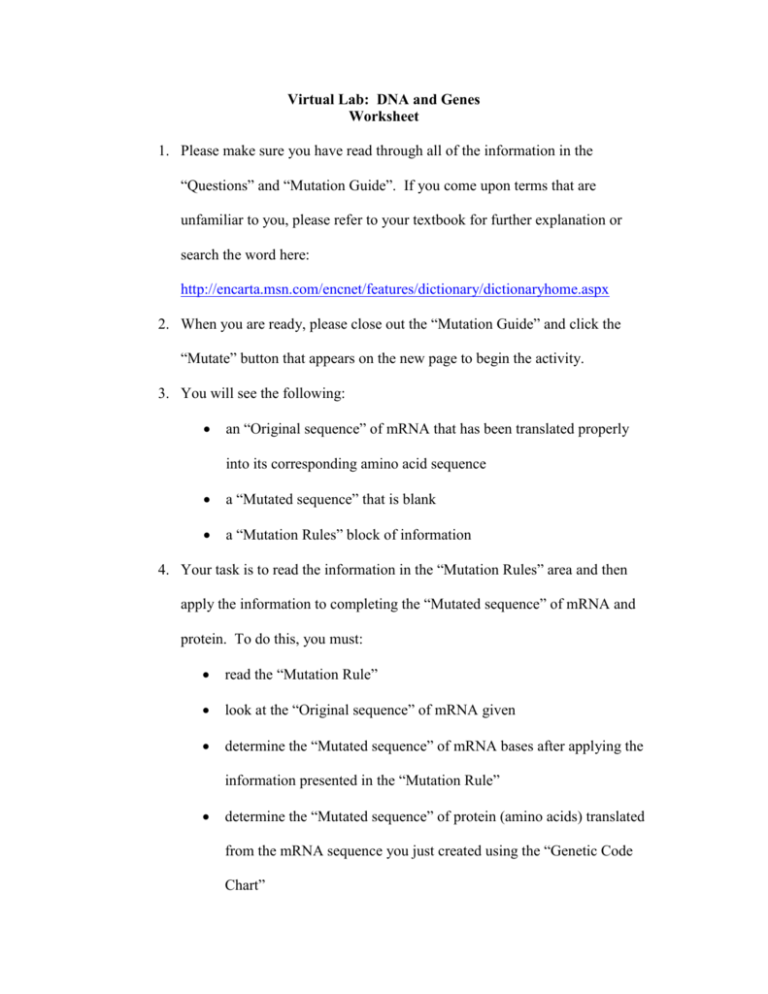
Virtual Lab: DNA and Genes Worksheet 1. Please make sure you have read through all of the information in the “Questions” and “Mutation Guide”. If you come upon terms that are unfamiliar to you, please refer to your textbook for further explanation or search the word here: http://encarta.msn.com/encnet/features/dictionary/dictionaryhome.aspx 2. When you are ready, please close out the “Mutation Guide” and click the “Mutate” button that appears on the new page to begin the activity. 3. You will see the following: an “Original sequence” of mRNA that has been translated properly into its corresponding amino acid sequence a “Mutated sequence” that is blank a “Mutation Rules” block of information 4. Your task is to read the information in the “Mutation Rules” area and then apply the information to completing the “Mutated sequence” of mRNA and protein. To do this, you must: read the “Mutation Rule” look at the “Original sequence” of mRNA given determine the “Mutated sequence” of mRNA bases after applying the information presented in the “Mutation Rule” determine the “Mutated sequence” of protein (amino acids) translated from the mRNA sequence you just created using the “Genetic Code Chart” 5. Please complete this information in the area below BEFORE actually completing the virtual activity; you can then refer to it to help make the correct selections at each step. Remember to use the “Genetic Code Chart” to determine the protein sequence: “Mutation Rule” states: ___________________________________________ Original Sequence: mRNA Protein Mutated Sequence: mRNA Protein 6. Once you have filled in the information above, drag the correct nucleotides to their position in the “Mutated sequence” of mRNA. Then drag the corresponding amino acids into place in the “Mutated sequence” of protein. When you are finished, click “Check”. A message will appear in the open box at the bottom of the page indicating whether your answer needs to be corrected. You may repeat this entire activity by clicking “Mutate”. 7. Please finish this exercise by opening the “Journal” link at the bottom of the page and answering the questions. Post-laboratory Questions: 1. A mutation: a. Results in a change in DNA sequence b. Can result in abnormal encoding of protein sequences c. Is always detrimental d. A and B e. All of the above 2. During the process of transcription: a. DNA is turned into protein b. mRNA is turned into protein c. DNA is turned into mRNA 3. The building blocks of proteins are: a. Amino acids b. Nucleic acids c. Polysaccharides d. Fatty acids 4. Mutations: a. Occur roughly 1 in 100 nucleotides b. Occur roughly 1 in 1,000 nucleotides c. Occur roughly 1 in 10,000 nucleotides d. Never occur e. None of the above 5. In a protein: a. A single nucleotide change can alter the encoded protein and cause disease b. 2 or more amino acids are linked together c. Mutations always alter the encoded protein structure and function d. A and B e. All of the above 6. Silent mutations: a. Are a type of point mutation b. Code for the same amino acid as intended by the original sequence c. Always affect protein structure and function d. A and B e. All of the above 7. A frameshift mutation: a. Involves the addition or deletion of one or more nucleotides b. Results in a new codon sequence c. Results in a new amino acid sequence d. All of the above 8. A stop codon is: a. AUG b. UAC c. UAG d. UGG 9. The codon “CUG” specifies which amino acid? a. Serine (Ser) b. Tyr (Tyrosine) c. Leu (Leucine) d. Glu (Glutamic Acid) 10. If the DNA sequence “AUGGGACCUCCU” was changed to “AUGGGAAACCUCCU” this would result in: a. A point mutation b. A silent mutation c. A frameshift mutation
